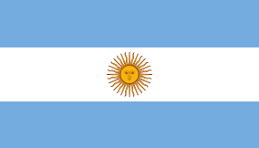Argentina flag Colors Code hex, png svg
History of the Argentine Flag
Design and Creation:
- The Argentine flag was designed by General Manuel Belgrano during the Argentine War of Independence.
- It was first raised on February 27, 1812, in the city of Rosario.
Adoption:
- The flag was officially adopted as the national flag on July 20, 1816, shortly after Argentina declared independence from Spain.
Colors and Their Meanings
Light Blue and White:
- The flag consists of three horizontal bands of light blue, white, and light blue.
- Light Blue (Celeste): This color is said to represent the clear skies of Argentina. Another interpretation links the blue to the Virgin Mary, a highly revered figure in Argentine culture.
- White: The white band represents peace and honesty.
Sun of May:
- In 1818, the “Sun of May” (Sol de Mayo) was added to the center of the white band.
- Sun of May: This sun symbolizes the Inca sun god Inti and is a national emblem of Argentina, representing the May Revolution of 1810, which marked the beginning of the process toward independence.
Symbolism
- Sky and Clouds: A popular interpretation is that the blue and white colors represent the sky and clouds, respectively.
- Freedom and Independence: The colors are also seen as a symbol of Argentina’s struggle for independence and freedom from Spanish rule.
Variations
- Civil Flag: The civil flag consists only of the blue and white bands without the Sun of May.
- War Flag: The war flag, used by the armed forces, includes the Sun of May in the center.
The Argentine flag is a significant symbol of national pride and reflects the country’s history, culture, and values.
Guess the Flags Quiz
Sharing is caring 🤗

National Symbols 👇
- 🏁 National Flags
- 🦁 National Animals
- 🐦 National Birds
- 🌻 National Flowers
- 🌴 National Trees
- 🥭 National Fruits
- 🍹 National Drinks
- 👴 National Founders
- ☘️ National Emblems
- 🍲 National Dishes
- 🏛️ National Monuments
- ✍️ National Poets
- 🕌 National Mausoleums
- 🎺 National Instruments
- 🦸 National Heroes
- 📆 National Days

